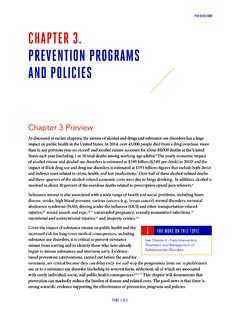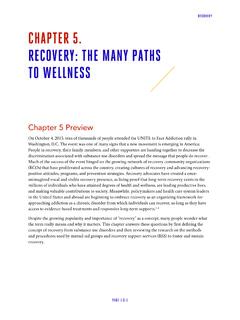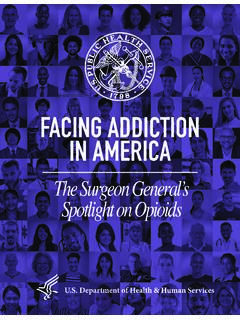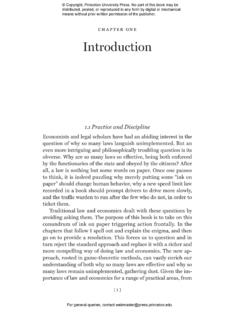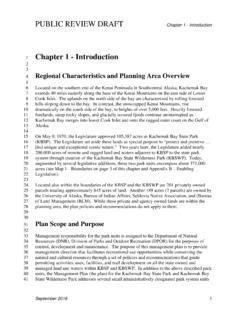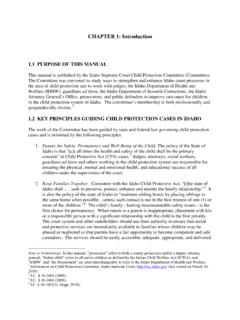Transcription of INTRODUCTION CHAPTER 1. INTRODUCTION AND OVERVIEW OF THE ...
1 INTRODUCTIONPAGE | 1- 1 chapter AND OVERVIEW OF THE REPORTC hapter 1 PreviewThe United States has a serious substance misuse problem. Substance misuse is the use of alcohol or drugs in a manner, situation, amount, or frequency that could cause harm to the user or to those around them. Alcohol and drug misuse and related substance use disorders affect millions of Americans and impose enormous costs on our society. In 2015, million people in the United States reported binge drinking in the past month and million people were current users of illicit drugs or misused prescription The accumulated costs to the individual, the family, and the community are staggering and arise as a consequence of many direct and indirect effects, including compromised physical and mental health, increased spread of infectious disease, loss of productivity, reduced quality of life, increased crime and violence, increased motor vehicle crashes.
2 Abuse and neglect of children, and health care costs. The most devastating consequences are seen in the tens of thousands of lives that are lost each year as a result of substance misuse. Alcohol misuse contributes to 88,000 deaths in the United States each year; 1 in 10 deaths among working adults are due to alcohol In addition, in 2014 there were 47,055 drug overdose deaths including 28,647 people who died from a drug overdose involving some type of opioid, including prescription pain relievers and heroin more than in any previous year on Even though the United States spends more than any other country on health care, it ranks 27th in life expectancy.
3 Which has plateaued or decreased for some segments of the population at a time when life expectancy continues to increase in other developed countries and the difference is largely due to substance misuse and associated physical and mental health problems. For example, recent research has shown an unprecedented increase in mortality among middle-aged White Americans between 1999 and 2014 that was largely driven by alcohol and drug misuse and suicides, although this trend was not seen within other racial and ethnic populations such as Blacks and An analysis from the Centers for Disease Control and Prevention (CDC) demonstrated that alcohol and drug misuse accounted for a roughly 4-month decline in life expectancy among White Americans.
4 No other cause of death had a larger negative impact in this | 1-2 Substance misuse and substance use disorders also have serious economic consequences, costing more than $400 billion annually in crime, health, and lost ,11 These costs are of a similar order of magnitude to those associated with other serious health problems such as diabetes, which is estimated to cost the United States $245 billion each Alcohol misuse and alcohol use disorders alone costs the United States approximately $249 billion in lost productivity, health care expenses, law enforcement, and other criminal justice The costs associated with drug use disorders and use of illegal drugs and non-prescribed medications were estimated to be more than $193 billion in decades of expense and effort focused on a criminal justice based model for addressing substance use-related problems, substance misuse remains a national public health crisis that continues to rob the United States of its most valuable asset: its people.
5 In fact, high annual rates of past-month illicit drug use and binge drinking among people aged 12 years and older from 2002 through 2014 (Figure ) emphasize the importance of implementing evidence-based public-health-focused strategies to prevent and treat alcohol and drug problems in the United public health approach seeks to improve the health and safety of the population by addressing underlying social, environmental, and economic determinants of substance misuse and its consequences, to improve the health, safety, and well-being of the entire : Past Month Rates of Substance Use Among People Aged 12 or Older.
6 Percentages, 2002-2014, 2014 National Survey on Drug Use and Health (NSDUH) Notes: The National Survey on Drug Use and Health (NSDUH) obtains information on nine categories of illicit drugs: marijuana (including hashish), cocaine (including crack), heroin, hallucinogens, and inhalants, as well as the nonmedical use of prescription-type pain relievers, tranquilizers, stimulants, and sedatives; see the section on nonmedical use of psychotherapeutic drugs for the definition of nonmedical use. Estimates of illicit drug use reported from NSDUH reflect the use of these nine drug categories.
7 Difference between the Illicit Drug Use estimate for 2002-2013 and the 2014 estimate is statistically significant at the .05 level for all years against 2014. Binge drinking for NSDUH data collected in 2014 is defined as five or more drinks on the same occasion on at least one day in the past 30 days. There was no significant difference between 2002-2013 against 2014. In 2015, changes were made to the NSDUH questionnaire and data collection procedures that do not allow comparisons between 2015 and previous years for a number of : Center for Behavioral Health Statistics and Quality, (2015).
8 13 INTRODUCTIONPAGE | 1-3 This Surgeon General s Report has been created because of the important health and social problems associated with alcohol and drug misuse in America. As described in this Report, a comprehensive approach is needed to address substance use problems in the United States that includes several key components: $Enhanced public education to improve awarenessabout substance use problems and demand for moreeffective policies and practices to address them;$Widespread implementation of evidence-basedprevention policies and programs to preventsubstance misuse and related harms.
9 $Improved access to evidence-based treatmentservices, integrated with mainstream health care,for those at risk for or affected by substance usedisorders;$Recovery support services (RSS) to assist individualsin maintaining remission and preventing relapse; and$Research-informed public policies and financingstrategies to ensure that substance misuse and usedisorder services are accessible, compassionate,efficient, and these needs, the Report explains the neurobiological basis for substance use disorders and provides the biological, psychological, and social frameworks for improving diagnosis, prevention, and treatment of alcohol and drug misuse.
10 It also describes evidence-based prevention strategies, such as public policies that can reduce substance misuse problems ( , driving under the influence [DUI]); effective treatment strategies, including medications and behavioral therapies for treating substance use disorders; and RSS for people who have completed treatment. Additionally, the Report describes recent changes in health care financing, including changes in health insurance regulations, which support the integration of clinical prevention and treatment services for substance use disorders into mainstream health care practice, and defines a research agenda for addressing alcohol and drug misuse as medical , this first Surgeon General s Report on Alcohol, Drugs, and Health is not issued simply because of the prevalence of substance misuse or even the related devastating harms and costs.
